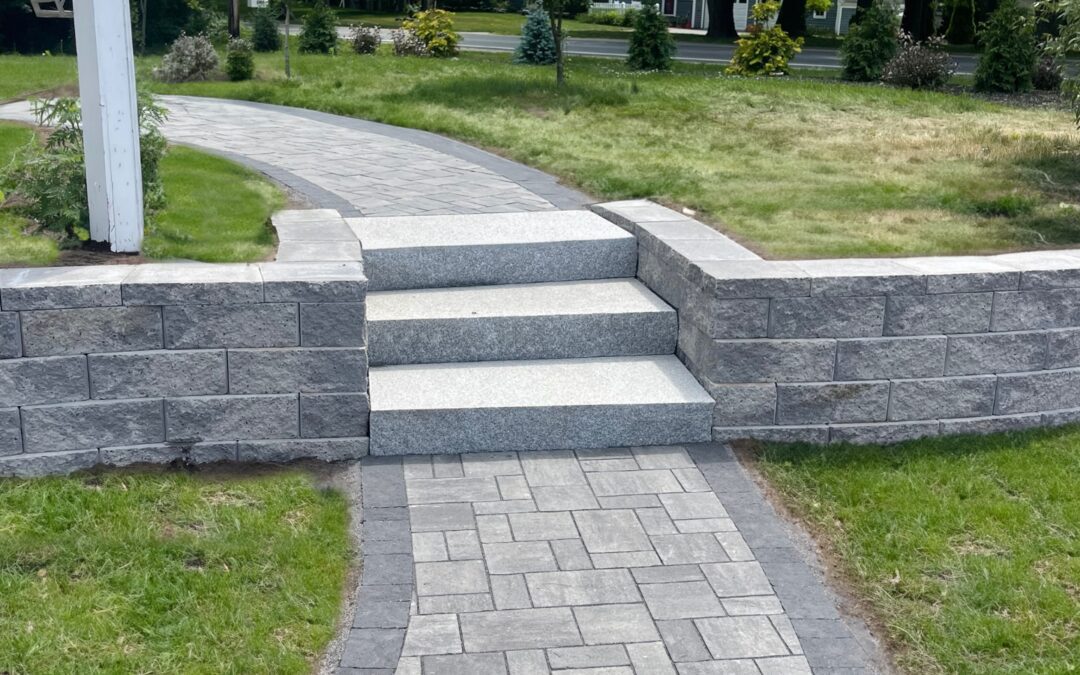As any homeowner in southern Maine can attest, there are many challenges presented with sloped yards, many of which may have surprised first-time homeowners. The good news is that there are solutions that not only overcome these challenges but also enhance the aesthetic and functional aspects of your outdoor living spaces. At Stone Solutions Maine, we specialize in turning these challenging slopes into attractive, functional outdoor spaces that showcase the beauty of your southern Maine home. Let’s explore ways we can tackle this seemingly uphill battle together.
Terracing: Creating Multi-Level Outdoor Living Spaces
Terracing is a transformative landscaping technique that unlocks the potential of sloped yards, turning them into functional and visually appealing multi-level outdoor spaces. By strategically constructing a series of retaining walls, terracing creates a stair-stepped effect that divides the slope into a series of level platforms or terraces.

These terraced levels provide a versatile foundation for various outdoor living areas, allowing homeowners to maximize the usable space on their sloped property. From lush gardens and vibrant flower beds to cozy seating areas, outdoor kitchens, and recreational spaces, the possibilities are endless when you harness the power of terracing.
One of the primary advantages of terracing is its ability to minimize soil erosion, a common issue on sloped terrains. By breaking up the slope into multiple levels, terracing reduces the force of water runoff and prevents soil from being carried away, ensuring the longevity and stability of your outdoor spaces.
In addition to its practical benefits, terracing also adds a visually striking element to your landscape design. The series of retaining walls creates a sense of depth and dimension, adding texture and interest to the overall aesthetic. Carefully planned terraces can serve as focal points, guiding the eye through the landscaped areas and creating a harmonious flow throughout the outdoor living spaces.

Whether you envision a tranquil garden retreat, a lively entertainment area, or a combination of both, terracing offers a versatile solution for transforming sloped yards into functional and beautiful multi-level outdoor sanctuaries tailored to your unique preferences and lifestyle.
Retaining Walls: Functional and Aesthetic Solutions
There are three main categories for retaining walls. They all aim to accomplish the same goal of protecting your yard from erosion, but they differ in their construction methods and materials.
Gravity Retaining Walls
Gravity retaining walls rely heavily on their mass to hold them in place to stabilize the retained soil. These are ideal for homes where the aesthetic of natural stone can be featured. They are typically constructed using large, heavy stones or concrete blocks that are stacked and interlocked, with their weight providing the necessary resistance against the soil pressure.
Cantilevered Retaining Walls
These use less material by using a lever action between the wall and the footing. Due to their strength and minimal footprint, they are often used in commercial and industrial projects. Cantilevered retaining walls are reinforced with steel or concrete, and the base is designed to resist the soil pressure by transferring it to the foundation.
Sheet Piling Retaining Walls
Sheet piling is typically reserved for soft soils and tight spaces where other materials may not be able to fit. Sheet piling retaining walls are constructed by driving interlocking steel or vinyl sheets into the ground, creating a continuous wall that can withstand significant soil pressures.
The Purpose and Benefits of Retaining Walls
The purpose of retaining walls is very similar to that of terracing. Only a retaining wall can be built alone, while terracing is a series of retaining walls. Retaining walls are crucial to creating usable spaces out of sloped landscapes. They provide structural support, aesthetic appeal, and enhancement to the overall landscape design. By holding back soil, retaining walls prevent erosion, allow for level areas to be created, and offer opportunities for unique landscaping features such as raised gardens, seating areas, and water features.

Stone Materials Used for Retaining Walls
There are many materials that can be used for retaining walls. Each presents a different aesthetic and benefits depending on the type of wall you would like to build, but all offer durable structures for your yard. These materials are often used for retaining walls:
Fieldstone
Fieldstones tend to vary in size and shape and are light tan, brown, red, or gray, depending on where they are sourced. These tones provide an organic, earthy appearance that blends well with any landscape.
Concrete Block
Concrete blocks are precast in a variety of shapes and sizes. They can create a uniform and clean look that lends itself to more formal or modern design styles.

Designing Beyond the Wall
With proper planning, retaining walls can transcend their primary function of soil retention. They can serve as the groundwork for a myriad of features, such as built-in seating, raised planter beds, tiered gardens, and even water installations. This potential for creativity makes them the focal point of your outdoor living spaces.

Technical Masonry Considerations for Sloped Yards
Proper Drainage Systems
Water is one of the most crucial factors contributing to erosion control, so it is essential to address any drainage issues to prevent water accumulation that could lead to potential structural failure of the wall. There are a few different drainage systems available.
Weep Holes
These small openings, left in the face of the retaining wall, allow water to escape from behind the wall, preventing pressure.
Drainage Tiles (Pipes)
Drainage tiles, also known as perforated or drain pipes, are installed behind the retaining wall at the base or within the backfill to channel excess water away from the wall, improving drainage.
Gravel Drains
For this method, a layer of gravel or crushed stone is placed behind and sometimes beneath the retaining wall to help rapidly move water down through the soil and away from the wall.
French Drains
A French drain is a more comprehensive drainage system that involves creating a gravel or rock-filled trench containing a perforated pipe to direct water away from an area. This prevents ground or surface water from damaging foundations or as part of the drainage system behind a retaining wall.

Soil Type and Compaction Analysis
Understanding the soil type and compaction levels of your yard is crucial for the success and longevity of your retaining wall project. Different soil types have varying load-bearing capacities, drainage properties, and compaction requirements. It is essential to have a professional conduct a thorough soil analysis to determine the appropriate foundation, reinforcement techniques, and drainage solutions for your specific soil conditions. Proper soil compaction is also critical to ensure the stability and structural integrity of the retaining wall.
Base Preparation and Reinforcement Techniques
Base preparation is a critical step in the construction of retaining walls. It involves excavating and leveling the ground, removing any organic materials or debris, and ensuring a solid foundation for the wall. Depending on the soil conditions and the height of the retaining wall, reinforcement techniques may be necessary to provide additional stability and strength.
Geogrid Reinforcement
Geogrids are synthetic meshes made of polymer materials that are placed between layers of compacted soil or gravel. They help distribute the soil load and prevent lateral movement, providing increased stability for taller retaining walls.
Soil Anchors or Tiebacks
For particularly tall or heavily loaded retaining walls, soil anchors or tiebacks can be used. These are steel rods or straps that are driven into the soil behind the wall and anchored, providing additional support and resistance against soil pressure.
Proper base preparation and the use of appropriate reinforcement techniques ensure the long-term durability and safety of your retaining wall project, protecting your investment and minimizing the risk of failure or settlement.
We hope this blog has helped illuminate the potential your sloped yard holds and how to unlock this potential and maintain it for years to come. When you’re ready to start designing a custom hardscape solution to create the yard of your dreams, contact Stone Solutions Maine. We’ll work with you every step of the way, from design to installation, and bring your concepts to reality.

